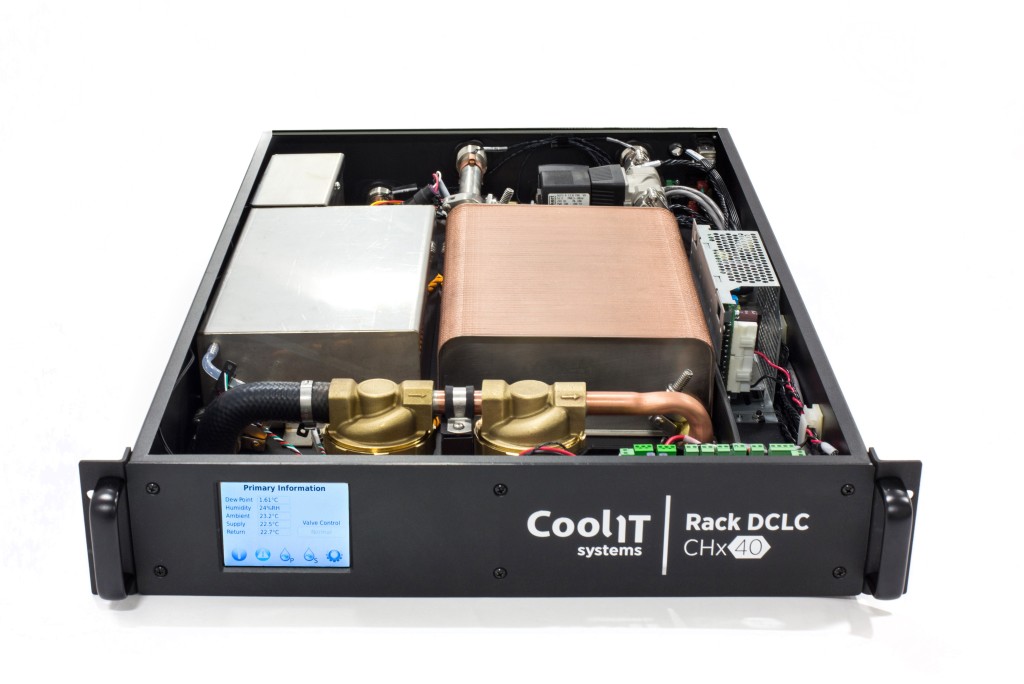There are a lot of excellent reasons why CoolIT Systems leads the field in Direct Contact Liquid Cooling (DCLC) for the data center, server and desktop markets. At the top of the list is innovation – since the company’s founding in 2001, CoolIT has created a portfolio of over 50 patents with more on the way.
One of the key innovative design decisions adopted to achieve superior performance and reliability by CoolIT is the use of centralized pumping systems as compared to distributed pumping. There are a number of advantages to taking this approach. Here are some of the primary ones and the reasons why centralized systems are superior to distributed pumping systems:
- Low-profile cold plates – CoolIT’s R4 Passive Cold Plate has a total height of only 15.6mm allowing it to easily fit into all server and blade configurations. On the other hand, in a distributed pumping system each cold plate has an integrated pump that extends too high to fit into 1U servers or narrow blade configurations.
- Moving parts – Centralized pumping systems place no moving parts inside the servers and the racks, therefore have nothing to fail. The system stays in place until the server is retired. In a distributed system, each cold plate is a pump, creating a point of failure that must be monitored and removed from the server if the pump fails.
- Points of failure – A rack with 100 processors requires only a single centralized pump. However, a similar rack serviced by a distributed system has 100 points of failure, each one on the server.
- Ease of maintenance – Pump maintenance is simple in a centralized system and handled onsite within the heat exchanger – not the server. But pump maintenance in a distributed system must be conducted inside the server – a time consuming process with a good chance of damaging other components.
- Balancing flow through servers – Centralized pumping through passive cold plates maintain an even flow distribution with minimal pressure changes from supply and return manifolds. This is not the case in distributed systems. Here multiple pumps over-pressure the return manifold and this pressure differential leads to potential problems including: reverse coolant flow from return to supply; reduced coolant flow; and, in a mix of single and dual pump loops, single pump loops can be starved of flow.
- Manifold complexity – A single manifold is all that it takes to maintain flow to all servers in a centralized system. In the distributed configuration, a full rack requires three separate manifolds in order to help counter the effect of over-pressurized return manifolds. More connections mean more failure points.
- High pressure facility water – In a centralized multiple rack scenario, the higher pressure facility water stops is not brought to the racks; in a single rack scenario, the higher pressure water is brought to the rack and stops at the heat exchange system. In a decentralized system, higher pressure water is brought directly to the rack at the heat exchange system.
- Cost of cold plates – A centralized system is very low cost as no pump is required. In a distributed system, you pay for a pump in each of the cold plates.
- Heat reuse – reusing the hot water coming from the servers to accomplish either tasks such as heating buildings is straightforward when the entire thermal load from the servers comes into a single termination point, from where it can be redistributed.
Centralized pumping systems are obviously the way to go when it comes to Direct Liquid Cooling and CoolIT is leading the way.
Find out more about Centralized Vs. Distributed Pumping for Rack-Based Direct Liquid Cooling



























































